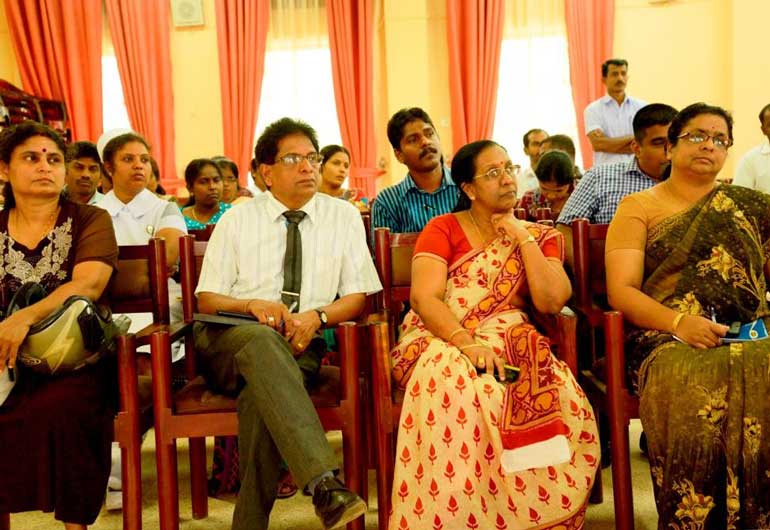Sunday May 05, 2024
Sunday May 05, 2024
Saturday, 29 August 2015 00:00 - - {{hitsCtrl.values.hits}}

Currently, patients washing their clothes causes wastewaterto run into open drains without a proper collection system

Audience, including Regional Director of Health Services and the Vice Director of the Vavuniya GH, atthe inauguration of the construction of the sewage system
In a bid to address one of the biggest risks jeopardising the environmental and health conditions in the Vavuniya township, the United Nations Office for Project Services (UNOPS) in partnership with the Regional Health Services Directorate initiated the construction of a sewerage and waste water treatment plant for the Vavuniya General Hospital.
These activities are being implemented with financial assistance provided through the European Union Support to District Development Programme (EU-SDDP), with a total financial envelope of EUR 60 million. The programme aims to support the Government of Sri Lanka’s thrust for economic and social development in seven conflict-affected districts covering half a million people.
The District General Hospital of Vavuniya is the second largest hospital in the Northern Provinceserving a population of around 400,000 from the districts of Vavuniya, Mullaitivu, Kilinochchi, Mannar and a part of Anuradhapura. The hospital’s current bed strength is 700 and an estimated 5,000 people seek outpatient assistance at the hospital daily, with a planned increase to 1,000 beds in the near future with ongoing development work to improve medical services.
In the context of the work that has commenced on Vavuniya General Hospital’s new sewerage and waste water treatment, LibuseSoukupova, Head of Development Cooperation for European Union in Sri Lanka said “Hospitals are not only significant consumers of water but also generate large amounts of wastewater. Ensuring efficient wastewater treatment and disposal is as equally important for general public health as drinking water treatment and garbage collection. This project reflects EU’s commitment to both the protection of the environment and the promotion of healthy living. We hope that the people of Vavuniya, will benefit greatly from initiative.”
The hospital’s current sewage disposal systemconsists of several overloaded septic tanks and clogged soakage pits. The effluent and sludge needs to be transportedto a disposal pit located approximately 12 km away at least six times per day using tankers.Also, the current practice of sullage disposal is creating significant health risks to the local community, as the hospital’s wastewater discharges to surface water drains or into the ground, leading to contamination of irrigation canals and eventual pollution of the surface and ground water system in the area.
With funding from the European Union, asewerage and waste water treatment plant has been designed to address this challenge by UNOPS in cooperation with the Regional Health Services Directorate and theHospital staff. Over the past two years,UNOPS engaged an international consultant to prepare an appropriate design for this plant.Through a series of consultations with officials and communities, this was revised and finalised, with the final designs being approved by the Central Environmental Authority (CEA) through an Initial Environment Examination (IEE) process.
The construction of the treatment plant was inauguratedon 28 July with the contractorbeing authorised by the Regional Director of Health Services–Vavuniya, ActingDirector of Vavuniya General Hospital and Acting Medical Officer of Health –Vavuniya.Hospital staff were made aware of the project scope and activity, with steps taken to minimise disruption to daily activities. The work on the plant is expected to be completed within 10 months.
Improvement in the hospital’s wastewater treatment and discharge system has been identified, among other things as an essential step to improve the social services provided by the hospital. Through this intervention it is hoped that the overall sanitary and hygiene conditions of the hospital will improve, while reducing the burden of transport costs for tankers to move the sewage on a daily basis. Overall, the plant will also contribute to upgrading the quality of health of the community in the Vavuniya township by minimising surface and irrigation water pollution.
Under the EU-SDDP framework, UNOPS is contributing to the construction and rehabilitation of social infrastructure and specific capacity building activities in Batticaloa, Mannar and Vavuniya Districts to benefit more than 600,000 people.